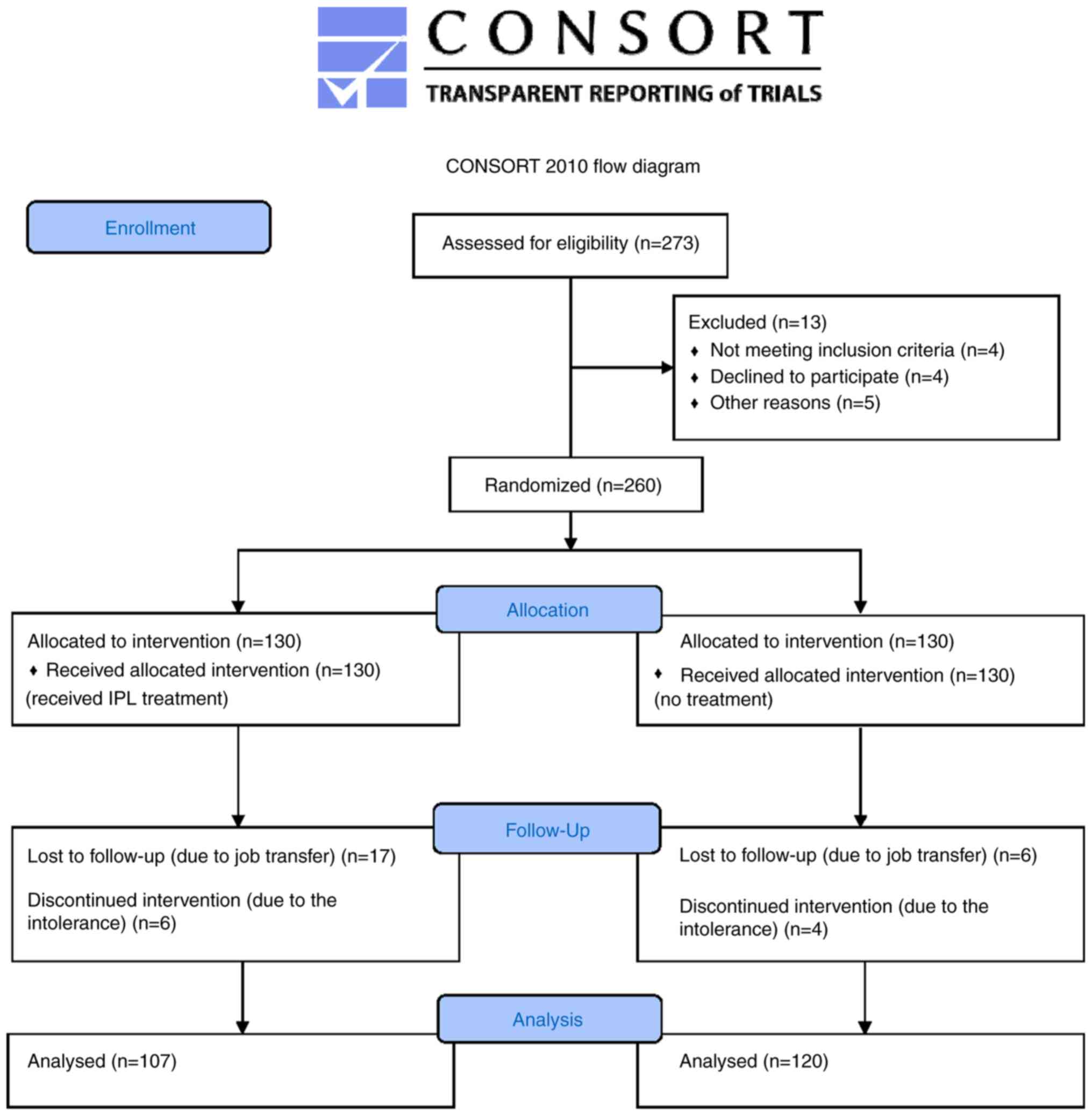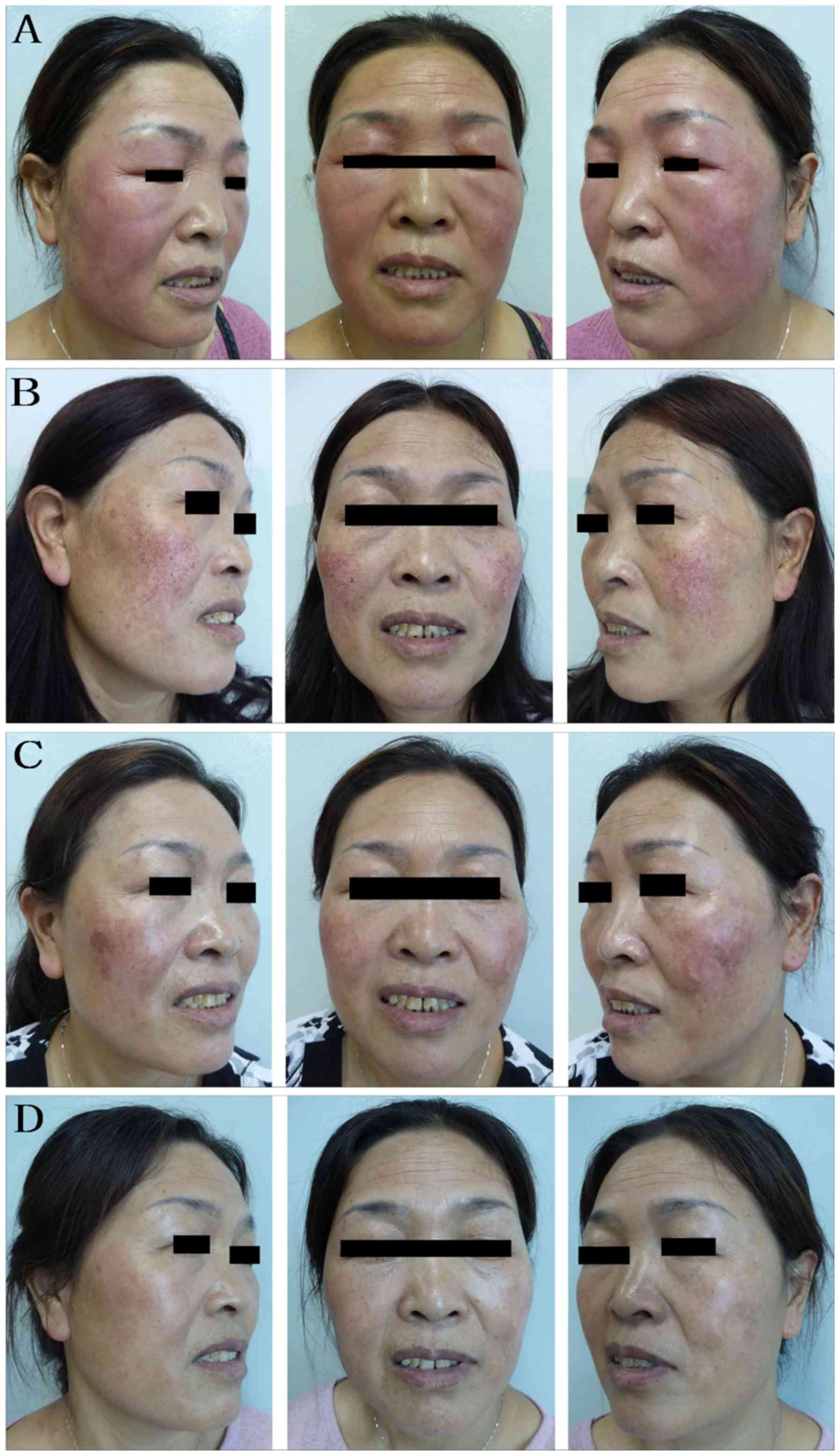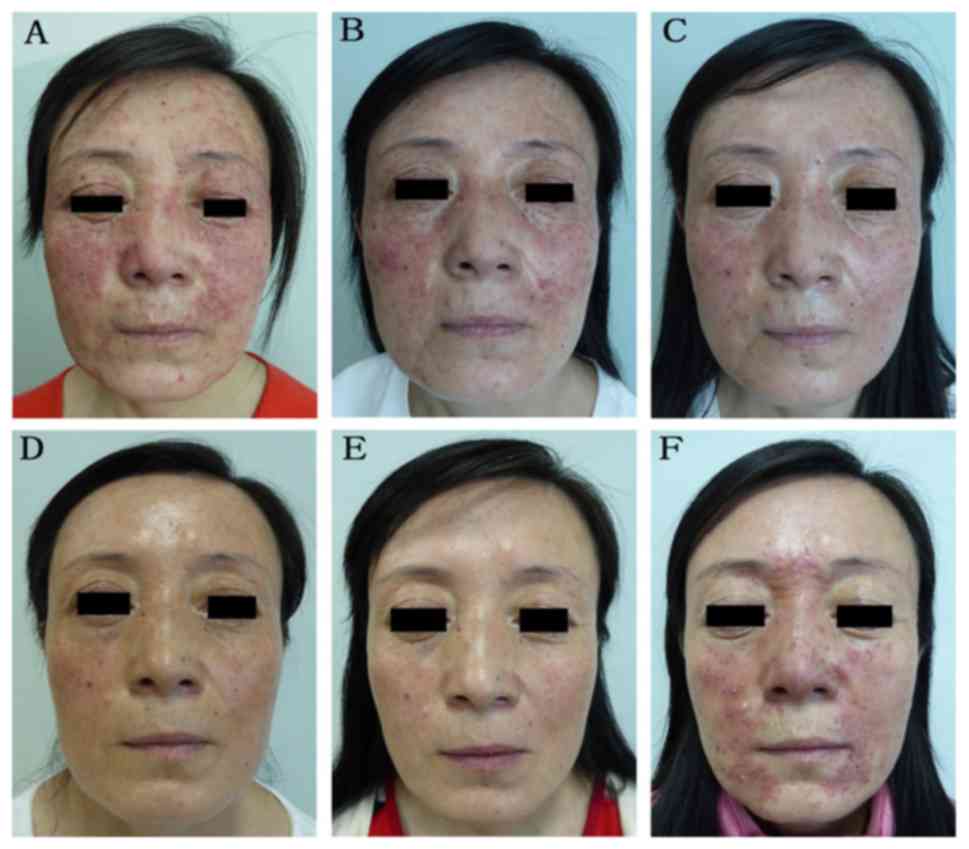|
1
|
Wilkin J, Dahl M, Detmar M, Drake L, Liang
MH, Odom R and Powell F: National Rosacea Society Expert C.
Standard grading system for rosacea: Report of the National Rosacea
Society Expert Committee on the classification and staging of
rosacea. J Am Acad Dermatol. 50:907–912. 2004.PubMed/NCBI View Article : Google Scholar
|
|
2
|
Crawford GH, Pelle MT and James WD:
Rosacea: I. Etiology, pathogenesis, and subtype classification. J
Am Acad Dermatol. 51:327–341; quiz 342-324. 2004.PubMed/NCBI View Article : Google Scholar
|
|
3
|
Wacker T and Lang GK: Demodex
folliculorum: Diagnosis and therapy today. Klin Monbl
Augenheilkd (German). 231:241–245. 2014.PubMed/NCBI View Article : Google Scholar
|
|
4
|
Alinia H, Tuchayi SM, James SM, Cardwell
LA, Nanda S, Bahrami N, Awosika O, Richardson I, Huang KE and
Feldman SR: Measurement of disease severity in a population of
rosacea patients. Dermatol Clin. 36:97–102. 2018.PubMed/NCBI View Article : Google Scholar
|
|
5
|
Oussedik E, Bourcier M and Tan J:
Psychosocial burden and other impacts of rosacea on patients'
quality of life. Dermatol Clin. 36:103–113. 2018.PubMed/NCBI View Article : Google Scholar
|
|
6
|
Egeberg A, Hansen PR, Gislason GH and
Thyssen JP: Patients with rosacea have increased risk of dementia.
Ann Neurol. 79:921–928. 2016.PubMed/NCBI View Article : Google Scholar
|
|
7
|
Faris C, Manjaly JG, Ismail-Koch H and
Caldera S: Rapid treatment of rhinophyma with powered
microdebrider. Case Rep Otolaryngol. 2013(621639)2013.PubMed/NCBI View Article : Google Scholar
|
|
8
|
Egeberg A, Hansen PR, Gislason GH and
Thyssen JP: Patients with rosacea have increased risk of depression
and anxiety disorders: A danish nationwide cohort study.
Dermatology. 232:208–213. 2016.PubMed/NCBI View Article : Google Scholar
|
|
9
|
Gallo RL, Granstein RD, Kang S, Mannis M,
Steinhoff M, Tan J and Thiboutot D: Standard classification and
pathophysiology of rosacea: The 2017 update by the National Rosacea
Society Expert Committee. J Am Acad Dermatol. 78:148–155.
2018.PubMed/NCBI View Article : Google Scholar
|
|
10
|
Micali G, Dall'Oglio F, Verzi AE, Luppino
I, Bhatt K and Lacarrubba F: Treatment of erythemato-telangiectatic
rosacea with brimonidine alone or combined with vascular laser
based on preliminary instrumental evaluation of the vascular
component. Lasers Med Sci. 33:1397–1400. 2018.PubMed/NCBI View Article : Google Scholar
|
|
11
|
Kennedy Carney C, Cantrell W and Elewski
BE: Rosacea: A review of current topical, systemic and light-based
therapies. G Ital Dermatol Venereol. 144:673–688. 2009.PubMed/NCBI
|
|
12
|
Del Rosso JQ, Tanghetti EA, Baldwin HE,
Rodriguez DA and Ferrusi IL: The burden of illness of
erythematotelangiectatic rosacea and papulopustular rosacea:
Findings from a web-based survey. J Clin Aesthet Dermatol.
10:17–31. 2017.PubMed/NCBI
|
|
13
|
Luo Y, Sun YJ, Zhang L and Luan XL:
Treatment of mites folliculitis with an ornidazole-based sequential
therapy: A randomized trial. Medicine (Baltimore).
95(e4173)2016.PubMed/NCBI View Article : Google Scholar
|
|
14
|
Luo Y, Luan XL, Sun YJ, Zhang L and Zhang
JH: Effect of recombinant bovine basic fibroblast growth factor gel
on repair of rosacea skin lesions: A randomized, single-blind and
vehicle-controlled study. Exp Ther Med. 17:2725–2733.
2019.PubMed/NCBI View Article : Google Scholar
|
|
15
|
Anzengruber F, Czernielewski J, Conrad C,
Feldmeyer L, Yawalkar N, Hausermann P, Cozzio A, Mainetti C,
Goldblum D, Goldblum D, et al: Swiss S1 guideline for the treatment
of rosacea. J Eur Acad Dermatol Venereol. 31:1775–1791.
2017.PubMed/NCBI View Article : Google Scholar
|
|
16
|
Lowe E and Lim S: Paradoxical erythema
reaction of long-term topical brimonidine gel for the treatment of
facial erythema of rosacea. J Drugs Dermatol. 15:763–765.
2016.PubMed/NCBI
|
|
17
|
Husain Z and Alster TS: The role of lasers
and intense pulsed light technology in dermatology. Clin Cosmetic
and Invest Dermatol. 9:29–40. 2016.PubMed/NCBI View Article : Google Scholar
|
|
18
|
Tanghetti EA, Jackson JM, Belasco KT,
Friedrichs A, Hougier F, Johnson SM, Kerdel FA, Palceski D, Hong
HC, Hinek A and Cadena MJ: Optimizing the use of topical
brimonidine in rosacea management: Panel recommendations. J Drugs
Dermatol. 14:33–40. 2015.PubMed/NCBI
|
|
19
|
Gao L, Gao N, Song W, Dang E, Yin R, Wang
L and Wang G: A retrospective study on efficacy of pulsed dye laser
and intense pulsed light for the treatment of facial
telangiectasia. J Drugs Dermatol. 16:1112–1116. 2017.PubMed/NCBI
|
|
20
|
Jansen T: Clinical presentations and
classification of rosacea. Ann Dermatol Venereol. 138:S192–S200.
2011.PubMed/NCBI View Article : Google Scholar
|
|
21
|
Jansen T: Clinical presentations and
classification of rosacea. Ann Dermatol Venereol. 138
(Suppl):S138–S147. 2011.PubMed/NCBI View Article : Google Scholar
|
|
22
|
Fitzpatrick TB: The validity and
practicality of sun-reactive skin types I through VI. Arch
Dermatol. 124:869–871. 1988.PubMed/NCBI View Article : Google Scholar
|
|
23
|
Goldberg DJ: Current trends in intense
pulsed light. J Clin Aesthet Dermatol. 5:45–53. 2012.PubMed/NCBI
|
|
24
|
Dummer R, Graf P, Greif C and Burg G:
Treatment of vascular lesions using the VersaPulse variable pulse
width frequency doubled neodymium: YAG laser. Dermatology.
197:158–161. 1998.PubMed/NCBI View Article : Google Scholar
|
|
25
|
Wilkin J, Dahl M, Detmar M, Drake L,
Feinstein A, Odom R and Powell F: Standard classification of
rosacea. National Rosacea Society Expert Committee: Report of the
National Rosacea Society Expert Committee on the classification and
staging of Rosacea. J Am Acad Dermatol. 46:584–587. 2002.PubMed/NCBI View Article : Google Scholar
|
|
26
|
Xu Z, Tan X, Ye J, Zhang C, Zhao M and
Zhan F: Evaluation of measles catch-up immunization campaign in
Hubei, 2010. Chin J Viral Dis. 1:208–211. 2011.
|
|
27
|
Cribier B: Pathophysiology of rosacea:
Redness, telangiectasia, and rosacea. Ann Dermatol Venereol. 138
(Suppl):S184–S191. 2011.PubMed/NCBI View Article : Google Scholar
|
|
28
|
Agnoletti AF, DEC E, Parodi A, Schiavetti
I, Savarino V, Rebora A, Paolino S, Cozzani E and Drago F:
Etiopathogenesis of rosacea: A prospective study with a three-year
follow-up. G Ital Dermatol Venereol. 152:418–423. 2017.PubMed/NCBI View Article : Google Scholar
|
|
29
|
Forton FM: Papulopustular rosacea, skin
immunity and Demodex: Pityriasis folliculorum as a missing
link. J Eur Acad Dermatol Venereol. 26:19–28. 2012.PubMed/NCBI View Article : Google Scholar
|
|
30
|
Turgut Erdemir A, Gurel MS, Koku Aksu AE,
Falay T, Inan Yuksel E and Sarikaya E: Demodex mites in acne
rosacea: Reflectance confocal microscopic study. Australas J
Dermatol. 58:e26–e30. 2017.PubMed/NCBI View Article : Google Scholar
|
|
31
|
Abokwidir M and Feldman SR: Rosacea
management. Skin Appendage Disord. 2:26–34. 2016.PubMed/NCBI View Article : Google Scholar
|
|
32
|
Campolmi P, Bonan P, Cannarozzo G,
Bruscino N, Troiano M, Prignano F and Lotti T: Intense pulsed light
in the treatment of non-aesthetic facial and neck vascular lesions:
Report of 85 cases. J Eur Acad Dermatol Venereol. 25:68–73.
2011.PubMed/NCBI View Article : Google Scholar
|
|
33
|
Liu J, Liu J, Ren Y, Li B and Lu S:
Comparative efficacy of intense pulsed light for different erythema
associated with rosacea. J Cosmet Laser Ther. 16:324–327.
2014.PubMed/NCBI View Article : Google Scholar
|
|
34
|
Wong WR, Shyu WL, Tsai JW, Hsu KH, Lee HY
and Pang JHS: Intense pulsed light modulates the expressions of
MMP-2, MMP-14 and TIMP-2 in skin dermal fibroblasts cultured within
contracted collagen lattices. J Dermatol Sci. 51:70–73.
2008.PubMed/NCBI View Article : Google Scholar
|
|
35
|
Vigo L, Giannaccare G, Sebastiani S,
Pellegrini M and Carones F: Intense pulsed light for the treatment
of dry eye owing to meibomian gland dysfunction. J Vis Exp.
146:2019.PubMed/NCBI View
Article : Google Scholar
|
|
36
|
Rainer BM, Kang S and Chien AL: Rosacea:
Epidemiology, pathogenesis, and treatment. Dermatoendocrinol.
9(e1361574)2017.PubMed/NCBI View Article : Google Scholar
|
|
37
|
Lim HS, Lee SC, Won YH and Lee JB: The
efficacy of intense pulsed light for treating
erythematotelangiectatic rosacea is related to severity and age.
Ann Dermatol. 26:491–495. 2014.PubMed/NCBI View Article : Google Scholar
|
|
38
|
Babilas P, Schreml S, Szeimies RM and
Landthaler M: Intense pulsed light (IPL): A review. Lasers Surg
Med. 42:93–104. 2010.PubMed/NCBI View Article : Google Scholar
|
|
39
|
Kawana S, Ochiai H and Tachihara R:
Objective evaluation of the effect of intense pulsed light on
rosacea and solar lentigines by spectrophotometric analysis of skin
color. Dermatol Surg. 33:449–454. 2007.PubMed/NCBI View Article : Google Scholar
|

















